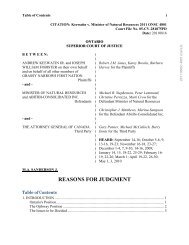COURT OF APPEAL FOR ONTARIO
COURT OF APPEAL FOR ONTARIO
COURT OF APPEAL FOR ONTARIO
You also want an ePaper? Increase the reach of your titles
YUMPU automatically turns print PDFs into web optimized ePapers that Google loves.
Page: 103<br />
[257] Second, we are not saying that a motion for summary judgment should never be<br />
brought in a simplified procedure action. There will be cases where such a motion is<br />
appropriate and where the claim can be resolved by using the powers set out in rule 20.04<br />
in a way that also serves the efficiency rationale in Rule 76. For example, in a documentdriven<br />
case, or in a case where there is limited contested evidence, both the full<br />
appreciation test and the efficiency rationale may be served by granting summary<br />
judgment in a simplified procedure action.<br />
[258] As we noted above at para. 58, a responding party faced with an inappropriate<br />
motion for summary judgment may move for directions under rules 1.04 and 1.05 to<br />
request that the motion be stayed or dismissed. If a stay or dismissal is granted and if a<br />
summary trial ultimately ensues, the affidavits prepared for the summary judgment<br />
motion can serve as affidavits under rule 76.12 in order to salvage some of the resources<br />
expended on the motion for summary judgment.<br />
[259] We now illustrate these general observations by applying them to the present<br />
case. As noted by the respondents, the motion judge was called on to resolve a number of<br />
disputed issues:<br />
(i)<br />
Should the respondent Scarfo be found personally<br />
liable given the conflicting evidence as to whether he<br />
or his company was responsible for the construction?<br />
(ii) Should the respondent homeowners be held<br />
vicariously liable for the damage caused?
















